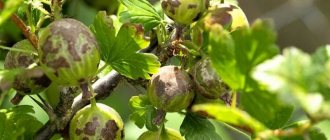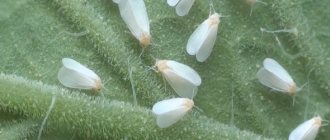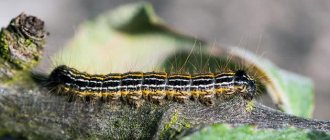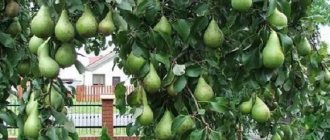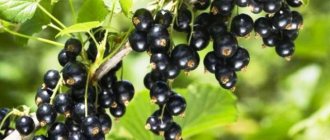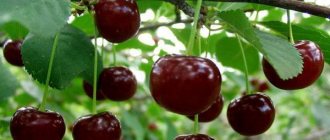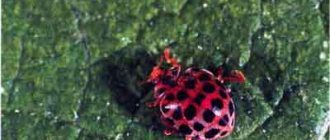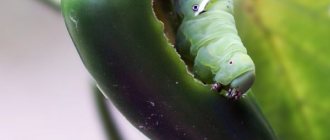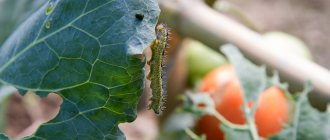Those caterpillars that eat apples are moths . And these are the most common and dangerous pests (since there are several types of them).
The most common are apple and oriental. These are butterflies whose larval stage feeds on both the pulp and seeds of the growing apple tree fruit. What causes its early fall and rapid decay. During a pest outbreak, up to ¾ of the entire apple harvest may be lost. In this article we will tell you how to save an apple tree from the codling moth .
Codling moth
Distributed throughout Russia in areas where fruit growing develops. It feeds exclusively on fruits and can destroy up to 90% of the crop in a season.
Main characteristics of the butterfly:
- color – gray-brown, with dark brown spots, transverse dark stripes and an oval yellowish spot at the top of the wing;
- the shape of the folded wing is roof-shaped;
- wingspan – 16–23 mm;
- body length 8–12 mm;
- laid eggs are light green, up to 1 mm in diameter;
- fertility – 50–200 eggs;
- number of generations per season – 1–3 depending on climatic conditions;
- peak flight - 10–12 days after the apple tree begins to bloom;
- egg laying – 7–10 days after the end of flowering when the average ambient temperature is +16…+18 °C.
Caterpillar:
- color – pale pink or flesh-colored with gray warts;
- head – brown;
- length – up to 22 mm;
- the pupa is light brown or beige with a golden tint, 9–12 mm long.
Life cycle
Mature individual of the first generation
The mass flight of sexually mature butterflies begins during the formation of the ovary on the apple tree and continues for 45–60 days. Maximum activity is observed in the evening hours, after sunset.
During this period, mating of individuals occurs, which ends with the stage of laying eggs. First of all, the pest lays eggs on the upper side of the leaf, then on the fruit.
Egg
In the laid egg, embryonic development begins, which lasts 9–12 days. During this period, the ambient temperature reaches a stable value of +20…+22 °C.
The development of second and third generation embryos requires significantly less time - 3–5 days from the start of laying.
Larva (caterpillar)
The hatching of caterpillars begins 15–17 days after the end of flowering of the latest varieties of apple trees.
Within 1–3 hours, the caterpillar moves to the fruit, and from that moment its defeat begins, which consists of several stages and is accompanied by stages of larval development:
- the caterpillar covers the selected fruit with a thin, almost invisible web;
- within 10–30 minutes it selects the most vulnerable place, gnaws through the skin and penetrates into the pulp of the fruit;
- having penetrated the fruit to a depth equal to the length of its own body, the caterpillar turns its head towards the hole and closes the passage with a dense plug consisting of pulp and cobwebs;
- for 24–48 hours the caterpillar feeds on the subcutaneous pulp, then gnaws out the chamber and molts in it for the first time;
- over the next 48 hours, it gnaws a hole into the seed chamber and molts a second time;
- having destroyed the seeds in the chamber, the larva molts again;
- the last, fourth, stage of caterpillar development is accompanied by gnawing the exit from one fruit and moving to another.
The affected apple often appears ripe ahead of time, falls off, and rots. During the season, one caterpillar destroys up to 3 fruits.
A mature larva forms a dense cocoon in cracks in the bark of an apple tree or in the soil, at a depth of no more than 3–4 cm, while uncollected fallen leaves or weeds serve as additional shelter and protection.
Doll
When a stable temperature of +8...+10 °C is established in the spring, the caterpillar begins the pupation process. The development of the pupa lasts for 14–25 days and ends with the emergence of butterflies during the period when the apple tree begins to bloom.
how and when to treat apple trees to prevent worms in apples
Filipich
It was necessary to treat apples for worms in the summer after flowering, more than once, and set traps with sour compote!!! And now (more precisely, later) they are treating them for diseases!!! That’s just urea (as written in the previous answer) for diseases and spraying ... sometimes ... and the worms, especially in apples, don’t care about such treatment!!! They are already calmly resting at this time where they are supposed to, waiting for the next summer so that they can attack your apples again with new strength and energy!!!
I am the ONE who comes to HELP.
nothing, if there is a worm in an apple, then it is tasty, a worm is not a fool to eat sour meat.
Alexander Vysotsky
Apple tree diseases - Dacha Forum
Last fall, apple trees were treated first with a very strong urea solution, and then two weeks later with an iron one... Partially saved Melba, Antonovka, Osennee Nalivnoe... (dacha. vsb. ru)
dacha.wcb.ru
Nadezhda Kotsareva
Minimum 6 treatments, starting in winter. I already answered in detail somewhere.
dissenter
Remove carrion regularly. In spring, mulch with humus with a layer of 15 cm. Hunting belts.
Elena Orlova
before flowering, treat with a chemical preparation,
Valentine Capricorn
It rains every day now, but in general, already in the second half of September I take a 10-liter bucket of water, 400 (four hundred) grams of urea, and spray it on the foliage, yellow or still green, the trunk and also the bushes, I try the higher, the better and more accurately also in spring!!! BUT!! ! in the spring, even before the leaves bloomed, that is, simply along the crown, there were always apples and pears and they treated us and the children and also the neighbors, this year everyone has a little apples, after the cold winter, and the fruits are always HEALTHY, don’t be afraid of 400 grams - this is not a lot, only if the harvest is already harvested GOOD LUCK!! ! I read it in the calendar a long time ago, so I do it now, in some literature they write generally 700 grams, not 400 is enough, and I spray a plot of land along the crown, and when we pour water from the containers, I add phytosporin and also spray it, but this is already in early October, CHELYAB REGION
Oleg Shelest
So we will start with early spring processing. It is produced in March at an average daily temperature of +5C. For treatment, you need to use drugs such as DNOC - 40% or drug 30B. For the first drug, the dosage is 150 g / 10 l of water, and for the second - 300 - 400 ml / 10 l of water. These drugs are effective against the wintering stages of pests and mites. When a stronger leaf appears, and this is approximately the middle - end of April, then treat against the apple flower beetle, fruit pollen, bark beetle, aphids, and leaf rollers with the drug "actara" - 8 mg/10 l of water. In the first ten days of May, before the start of flowering, it is necessary to treat the apple tree against the codling moth - the preparations confidor or calypso or matcha. 10 days after flowering, re-treat with one of these drugs against the codling moth, but since it flies all summer, you need to wage a “war” with it throughout the entire growing season of the apple tree. If early spring treatment was not carried out with one of the above-mentioned preparations, then it can be replaced with autumn treatment, that is, after leaf fall, treatment is carried out either with DNOC - 40% or Preparation 30B. Well, that seems to be all!! ! Have a good harvest!!!
droplet
in the winter, hang pieces of lard, you will attract birds, they will eat worms in the summer, hang bottle traps for flies that lay faces in the fruits, hunting belts on the trunk in the spring (sticky glue for mice and wrapping film will do) dig up the trunk circles in the fall, and spray and spraying is not available to everyone
Oriental codling moth
Distribution: central Russia, southern regions, Crimea. A dangerous apple tree pest damages fruits and young shoots of the first year of growth. During the season it can destroy up to 100% of the crop.
It is a quarantine pest: the import of seedlings from places of mass development of the eastern codling moth is prohibited.
Main characteristics of the butterfly:
- color – dark gray and gray-brown, with off-white scales on the front wings, transverse light stripes and gray fringe;
- the shape of the folded wing is roof-shaped;
- the lower part of the wing is silver;
- antennae – gray, up to 24 mm long;
- wingspan – 10–14 mm;
- laid eggs are transparent, with a pearlescent tint, as they mature - pink, with a diameter of up to 0.4 mm;
- fertility – 180–200 eggs;
- the number of generations per season is 5–6.
Caterpillar:
- color – pale pink, flesh or white;
- head – black;
- length – 12–13 mm;
- pupa – brown, with sharp spines, 6–8 mm long;
- cocoon is transparent, length 10–12 mm.
Life cycle
Mature individual of the first generation
In spring, when the average daily temperature reaches +14…+16 °C, butterflies begin to emerge. The greatest activity is observed in cloudy weather and after sunset. After 3–5 days, the laying of eggs of the first generation begins on the upper side of the apple tree leaf, which lasts for 7–14 days.
Mature individuals of the second and subsequent generations lay eggs on fruits and stalks.
Egg
Embryonic development lasts 3–12 days depending on temperature conditions.
Larva (caterpillar)
Hatched caterpillars of the first generation penetrate the apical bud of a young shoot and gnaw through a passage up to 12 cm long, completely disrupting the sap flow and destroying the structure. The damaged shoot becomes unviable, dries out and dies. The mature larva pupates inside a dead shoot or in cracks in the tree bark.
The larvae of the second and subsequent generations feed on fruits and mature similarly to the caterpillars of the codling moth, but they rarely infect the seed pod, preferring apple pulp.
The average duration of larval development is 10–22 days, depending on the generation.
Doll
Pupae of the second and subsequent generations mature under fallen leaves, on the surface of damaged fruits or inside shoots damaged by the larvae of the first generation.
The maturation stage lasts for 5–10 days, then the development of the next generation begins.
The latest generation of caterpillars form cocoons in the upcoming wintering areas: in damaged bark, in uncleaned dry debris under a tree and in the soil at a depth of 2–3 cm.
The full development cycle from egg laying to subsequent maturation of a mature individual is 22–30 days.
Damage caused
The oriental codling moth causes irreparable damage due to significant damage to the tree. Such apple trees:
- do not develop due to the death of new shoots;
- lose frost resistance;
- have weak immunity to fungal or viral diseases;
- even after getting rid of the pest, they give a low yield due to disruption of the formation and development of new branches.
The yield loss is 100%, since due to the large number of generations and eggs laid, each fruit is attacked by up to 5–7 larvae.
The codling moth leads to a loss of 90% of the harvest, while its impact significantly reduces the tree's frost resistance and immunity to fungal diseases.
Preventive measures
To protect the apple tree from the attacks of the codling moth, you need to prepare for their attack. An effective solution would be to carry out simple measures with which a gardener can prevent garden crops from being damaged by insects:
- From time to time you need to visually inspect apple trees to identify areas with loose bark. If such zones are discovered, they should be cleared, thereby eliminating the shelter of individuals before wintering;
- digging up the soil in the root circle and loosening the soil will allow you to destroy invisible cocoons in the ground when the first frost occurs;
- sanitary pruning of damaged branches. You also need to periodically inspect the crown and foliage;
- cover up cracks in the trunk and branches, thereby reducing the number of places used by the codling moth butterfly to lay eggs;
- immediately collect and dispose of fallen apples, without waiting until there are enough fruits to fill several buckets;
- use catching belts and carry out preventive treatment of garden crops using biological or chemical agents.
An alternative option is breeding Trichogramma. These are hymenoptera insects that parasitize the clutches of pests, which can significantly reduce crop losses.
The best way to combat apple moths is to combine several options with the mandatory implementation of the specified preventive measures.
Source of the article: https://nashsadovod.ru/yablonya/plodozhorka-metody-borby
Pest control methods
It is possible to destroy adult individuals and larvae of the codling moth only through complex action. It is important to know that the codling moth larva - the caterpillar - is the weakest and most unstable link in development. The main control measures aimed at its destruction lead to the complete ridding of plantings from the pest.
Mechanical method
The mechanical way to get rid of the codling moth is as follows:
- removal of young shoots in the initial stage of infection by the eastern codling moth, while the cut areas must be cleaned and treated with garden varnish;
- collecting fallen fruits;
- collecting caterpillars from the surface of bark, leaves and fruits by hand;
- applying trapping belts in the lower and middle parts of the trunk in early spring before the butterfly begins to emerge.
Collected waste, damaged or affected parts of the plant must be destroyed by burning.
You can make a hunting belt yourself. To do this, take several strips of fabric or thick cardboard, dip them in an adhesive solution or grease them with Vaseline and secure them to the trunk and skeletal branches of the apple tree. As such a belt, you can use adhesive fly tape attached to fabric to avoid sticking to the trunk - the sticky solution is difficult to wash off and can damage the bark.
The following devices are used to kill butterflies:
- Pheromone trap . It is a triangular prism with a sticky bottom and a bait - a preparation containing codling moth pheromones that attract butterflies. Once trapped, the pest sticks to the tape and dies within 4–6 hours. For effective destruction, the adhesive tape should be replaced at least once every 7-10 days. One trap affects pests living on 3–5 trees.
- Sweet trap . To make it, you should prepare apple compote, adding three times the amount of sugar to it. Pour the prepared liquid into a container with a wide bottom and place it near trees. Considering that butterflies fly most often in the dark, a light source should be installed next to the trap - a table lamp or lantern. Codling moths, attracted by fire, fly to the trap site and drown. In this way, you can destroy 30–40% of butterflies.
Agrotechnical measures
They are carried out for the purposes of prevention, protection and as part of a set of measures to combat the pest. Are as follows:
- removal of dry branches damaged by fungal diseases;
- maintaining optimal distances when planting fruit trees;
- healing or removing damaged bark;
- timely destruction of weeds and root shoots from the tree trunk;
- timely fertilization of the apple tree with mineral supplements containing potassium and phosphorus in order to increase resistance to pest damage;
- compliance with the recommended rate of nitrogen fertilizer application;
- autumn and spring cleaning of dry leaves, fallen fruits and weed residues from the tree trunk;
- mandatory digging of the soil under the apple tree at least twice a season, followed by treatment with a pink solution of potassium permanganate or a solution of the biological preparation “Fitoverm”.
Fallen fruits can be collected in an airtight container, the bottom and walls of which are covered with glossy paper. The caterpillars, having left the apple, will not be able to move, will remain at the bottom and will not be able to continue their development.
Fighting with chemicals
Chemical control is an effective way to get rid of codling moths at any stage of development, and it is important to treat the affected plant throughout the season. To destroy the pest, use any of the drugs, diluted according to the attached instructions:
- "Coragen Expert Garden" . Does not cause addiction among pests. It affects all stages of pest development - from oviposition, larvae of all ages to adults. The first treatment with a working solution at the rate of 0.2 ml per 10 liters of water is carried out during the mass hatching of the larvae from eggs, 2-3 weeks after the apple tree blooms (coincides with the beginning of the white acacia flowering). The next 2-4 treatments are done at intervals of 2 weeks.
- "Dimilin" . Characterized by a long (30–40 days) period of exposure. Spray the tree three times at the green cone stage, then during the initial growing season and then after 10–14 days.
- "Kinmiks" . Involves three-time treatment before the beginning of the growing season and then after 12–15 days.
- "Aktellik" . Characterized by high speed of action. Instantly penetrates upon contact with the caterpillar and paralyzes its nervous system, leading to its inevitable death within 12–36 hours.
- "Fufanon" . Phosphorus-containing intestinal insecticide. Causes the death of the larvae within 24 hours.
- "Calypso" . Systemic insecticide of contact-intestinal action against gnawing pests on apple trees. It has a paralytic effect, leading to death, on larvae at various stages of maturation.
Fighting with biological drugs
The use of biological drugs has several advantages over chemicals:
- non-toxic to humans;
- the plants do not cause addiction to the components;
- are not inferior in efficiency;
- contain minerals necessary to nourish the tree;
- allowed to be used 3–5 days before harvest.
To destroy the codling moth, you should use:
- "Fitoverm" . Within 6–12 hours it causes paralysis of the larvae and leads to death within 24 hours. Effective even with extensive caterpillar infestation.
- "Lepidocide" . Safe for humans, effective against all stages of lepidopteran insects. It is used in any phase of tree and moth development.
- "Bitoxibacillin" . Intestinal insecticide. Leads to the death of the caterpillar within 12–36 hours.
Prevention and treatment of apple trees using traditional methods
Spraying the tree and spilling the soil with various infusions increases resistance to diseases and prevents the colonization and development of pests. Infusions are prepared based on:
- Onion peels: brew 3-5 dense handfuls in 5-7 liters of boiling water, leave for 3-5 hours.
- Insecticidal herbs - tansy, wormwood or burdock: 200 g of dried herbs per 5 liters of water.
- Tobacco: 500 g, pour 10 liters of hot water and leave for 2-3 days, dilute with warm water 1:2.
- Red pepper: boil 100 g of fresh fruit in 3 liters of water over low heat for 1–1.5 hours. Cool and dilute with water in a ratio of 1:3.
Thoroughly washing or spraying the apple tree with a soap solution prepared from 150 g of laundry soap and 10 liters of warm water provides protection against diseases and does not allow pests to gain a foothold on the trunk or leaves.
The soap solution can be added to the prepared infusions.
Treatment Chemicals
Some drugs can protect fruit plantings from attacks. They are used strictly according to the manufacturer’s instructions so as not to harm the crop and beneficial insects.
Fitoverm
When a codling moth is found on an apple tree, control methods require spraying the garden with a special composition. Fitoverm causes its death in 1 day, helps with massive dominance of the garden.
Is it possible to use herbicide
The description states that this subspecies is not used for manipulation due to the high risk of harm to trees.
Pesticides
Similar in action to insecticides, they cause the death of worms. Treatment is carried out:
- Ram;
- Tanrek;
- Confidor;
- Fastak, etc.
Important! Due to the cumulative effect, pesticides are stopped used a month before harvest.
Mixed insecticides
Complex use gives greater effect. Gardeners prefer the combination of Imidacloprid + Lambda-cyhalothrin, Thiamethox + Chlorantraniliprole.
Organophosphate insecticides
Toxic compounds with high efficiency. Gardeners use Dichlorvos and Karbofos due to their inexpensive price and low consumption.
Efficiency of funds


